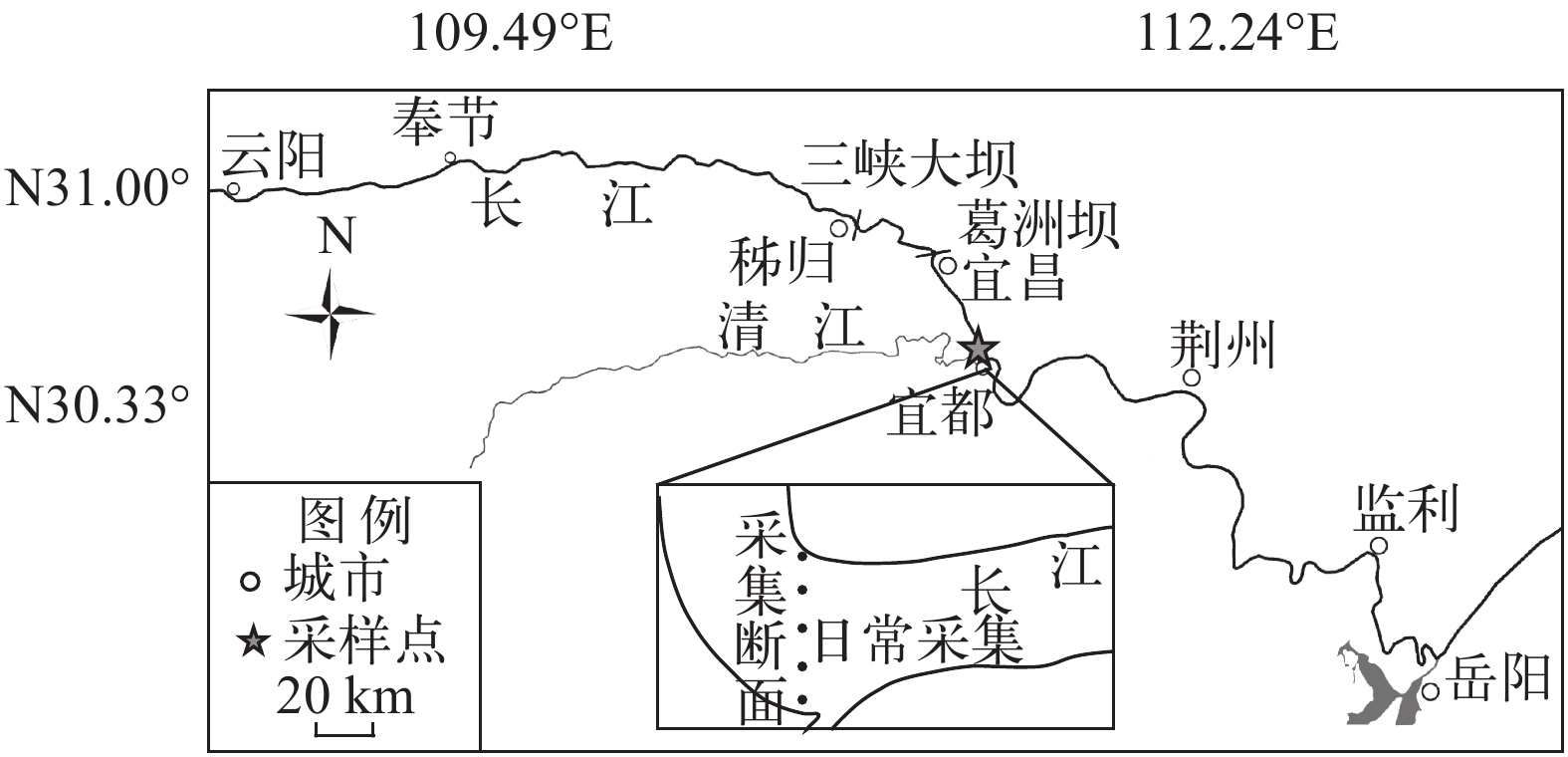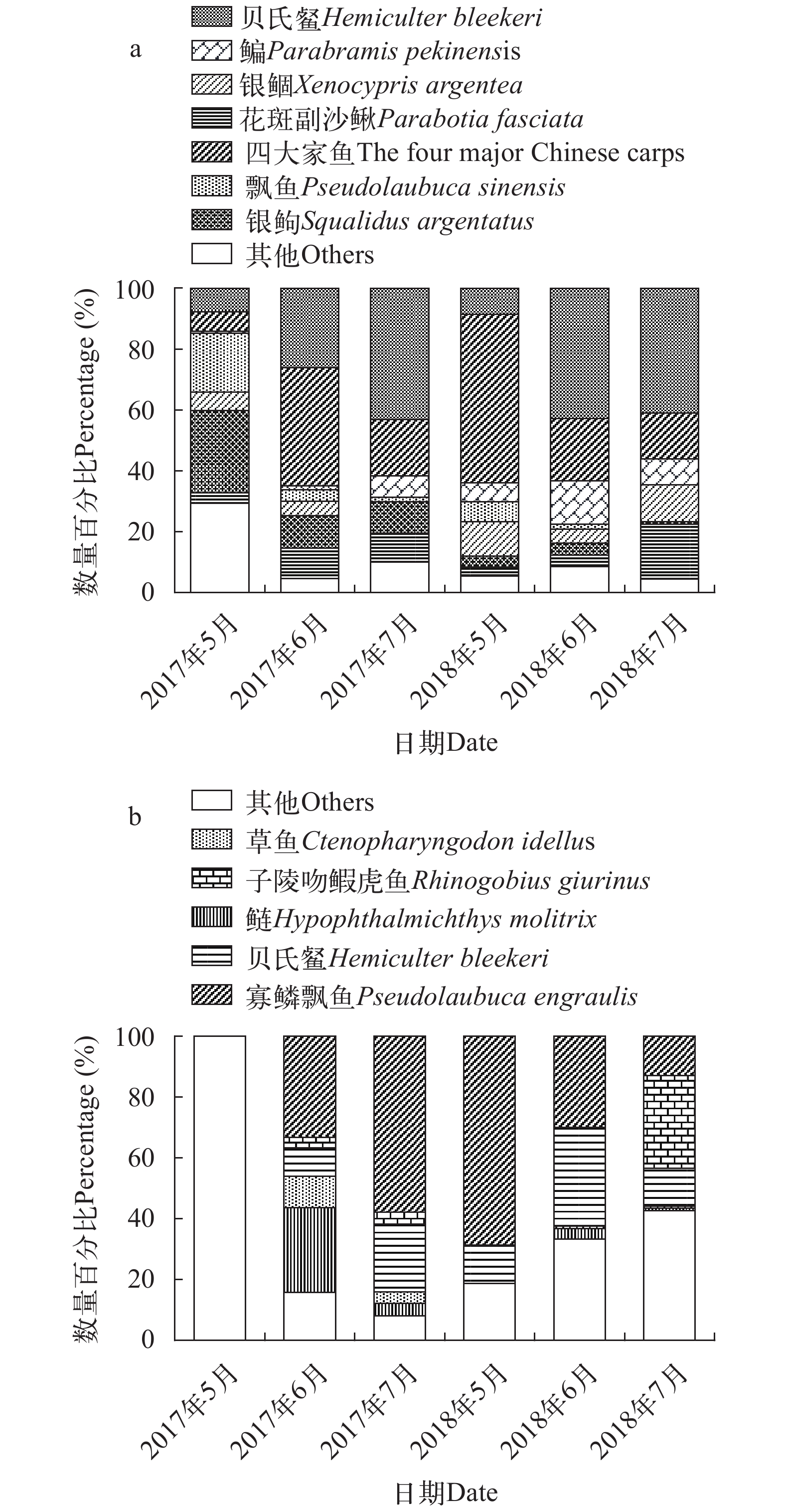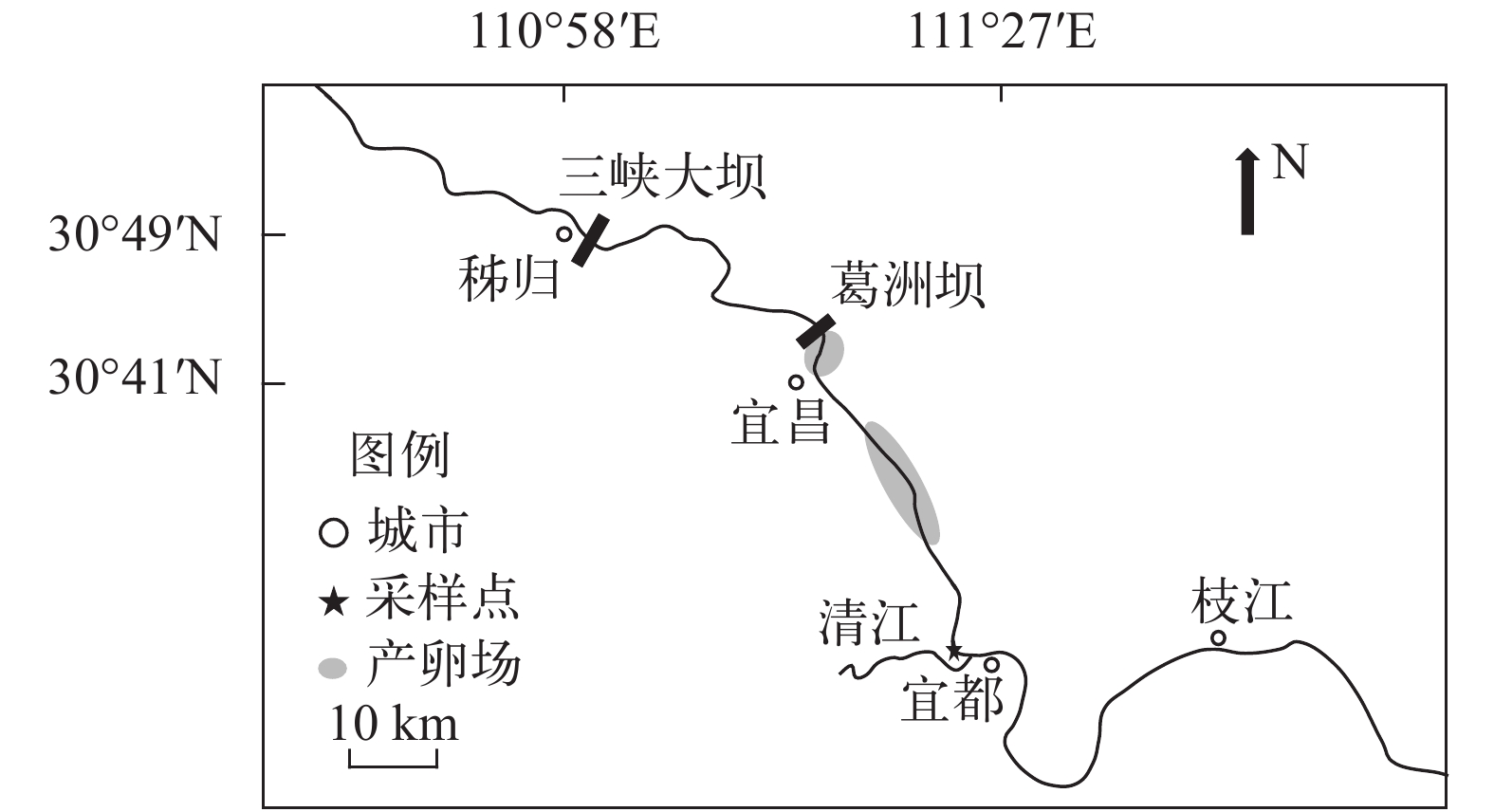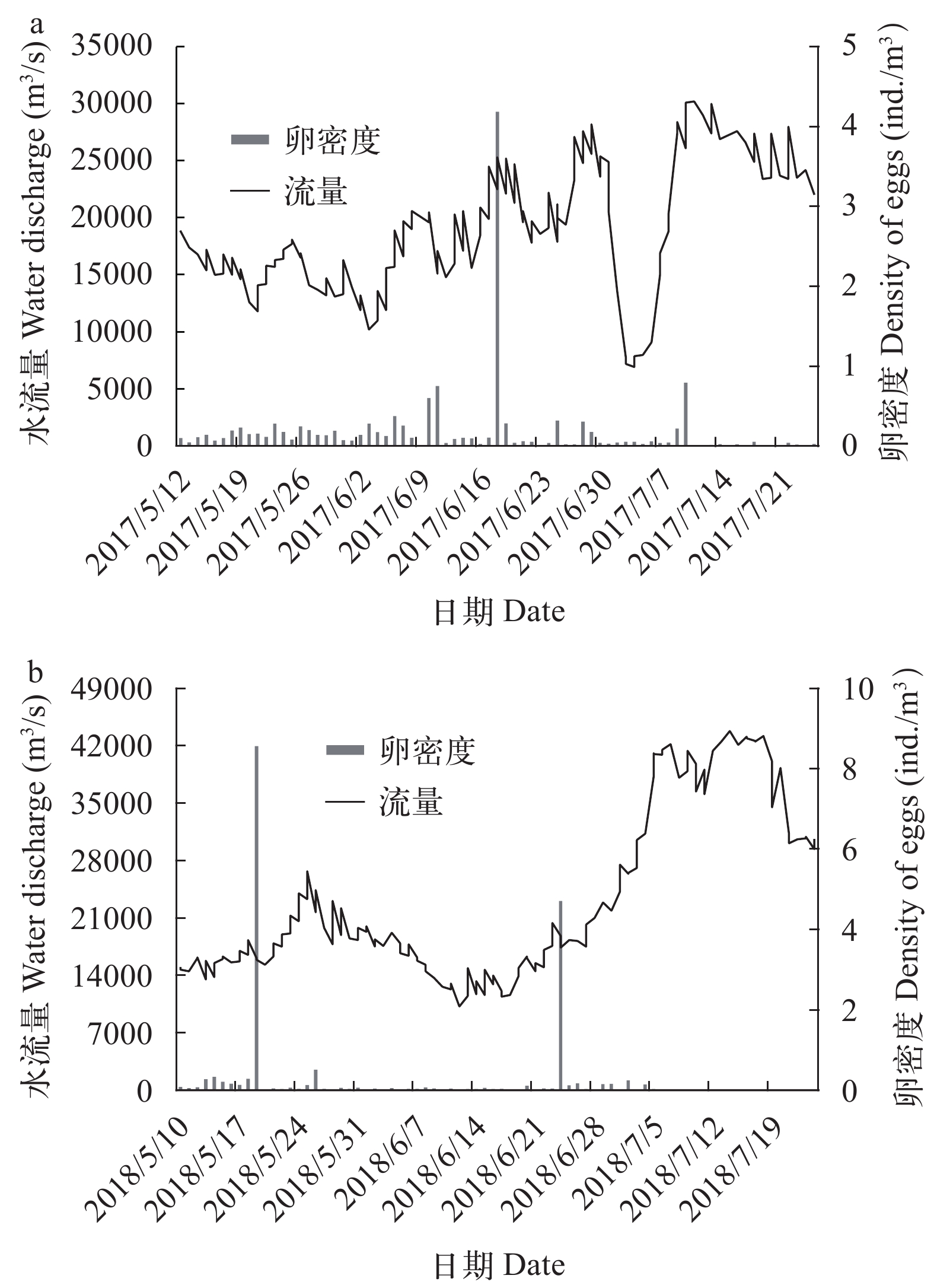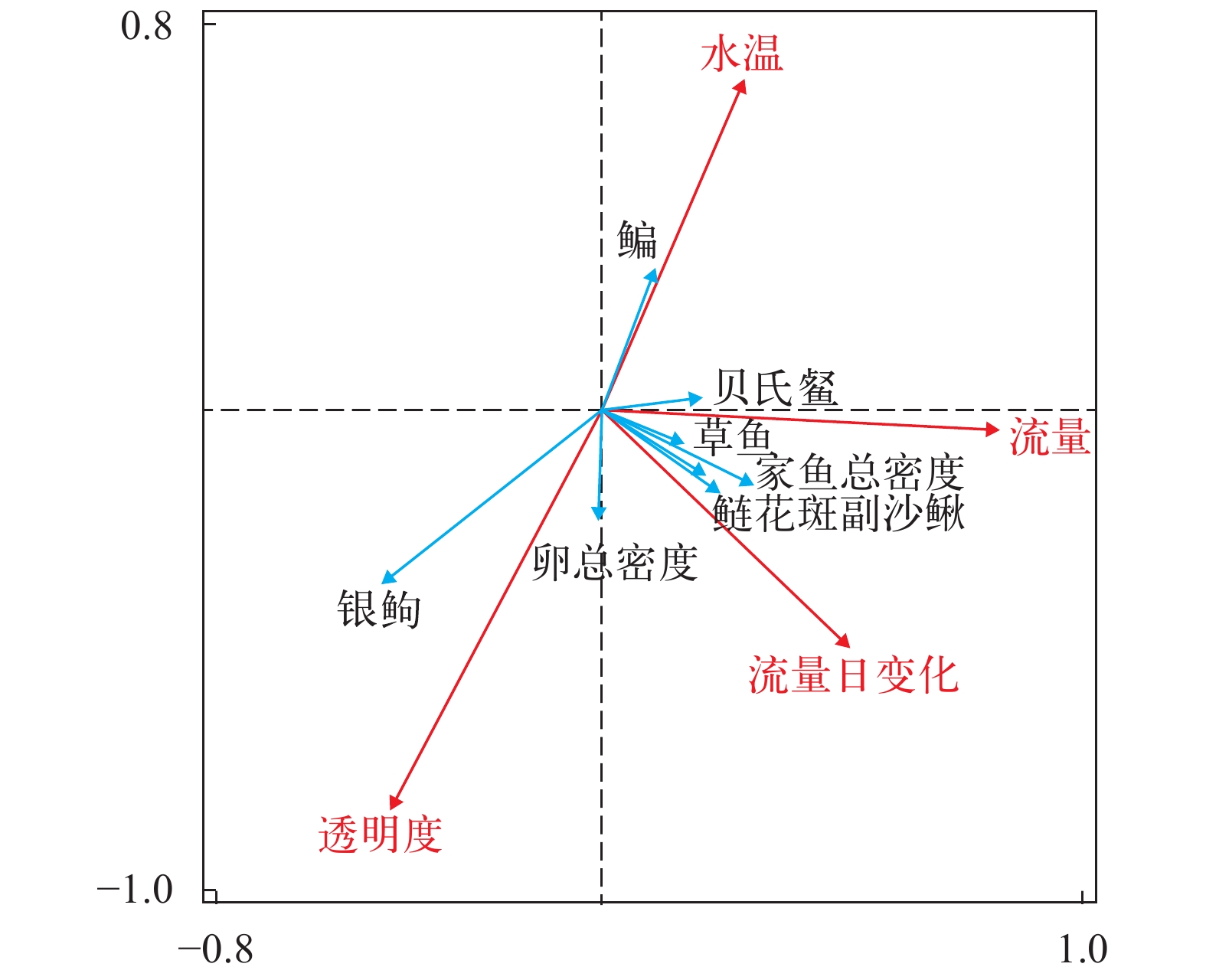THE STATUS OF THE EARLY-STAGE FISH RESOURCES AND HYDROLOGIC INFLUENCING CONDITIONS IN THE YICHANG SECTION IN THE MIDDLE REACHES OF THE YANGTZE RIVER
-
摘要: 为了解长江中游鱼类的早期资源现状, 2017年和2018年5—7月在长江干流宜都断面开展鱼类早期资源调查, 采样网具包括弶网和圆锥网。调查期间共采集鱼卵21120粒和仔鱼2123尾。利用形态学和分子生物学等方法, 鉴定鱼类5目9科37种。其中, 鱼卵有29种, 仔鱼有27种。2017年和2018年通过宜都断面的鱼卵径流量分别为124.45×108粒和101.07×108粒, 优势种为四大家鱼和贝氏䱗(Hemiculter bleekeri); 仔鱼径流量分别为16.43×108尾和8.29×108尾, 优势种为贝氏䱗和寡鳞飘鱼(Pseudolanbuca engraulis)。根据发育期和流速分析, 四大家鱼鱼卵来源于三峡大坝下游至宜都断面之间的产卵场, 仔鱼来源于三峡大坝以上的产卵场。与2009—2010年相比, 2017—2018年通过宜都断面的鱼卵径流量增大了85.3%, 尤其是四大家鱼的鱼卵径流量与2005—2012年相比增加了约13倍。冗余分析(Redundancy Analysis, RDA)结果显示, 流量和流量日变化对产漂流性鱼卵密度有影响。研究结果表明, 2017—2018年仍有大量的鱼卵和仔鱼补充到长江中游江段。与历史数据相比, 三峡大坝下游宜昌江段鱼类产卵规模有明显的增加, 可能与长江中游四大家鱼亲鱼增殖放流和生态调度等保护措施的实施有关。为了更加有效地保护长江中游的鱼类资源, 建议除了已经逐步实施的长江全面禁渔措施之外, 还应恢复江湖连通, 保护和修复长江中游河漫滩生境, 继续开展重要经济鱼类亲本放流, 以及开展生态调度。Abstract: In order to reveal the current status of the early-stage fish resources in the middle reaches of the Yangtze River, we conducted surveys in Yidu reach from May to July in 2017 and 2018. Sampling nets included a semi-conical net and a conical net. A total of 21120 eggs and 2123 larvae were collected. A total of 37 species in 9 families and 5 orders were identified using both morphological and molecular methods. Among which, 29 and 27 species were identified in eggs and larvae, respectively. We estimated that 124.45×108 ind eggs and 16.43×108 ind larvae drifted through Yidu reach in 2017, while 101.07×108 ind eggs and 8.29×108 ind larvae drifted through Yidu reach in 2018. The four major Chinese carps and Hemiculter bleekeri were the dominant species in eggs while Hemiculter bleekeri and Pseudolanbuca engraulis were the dominant species in larvae. According to the analysis of development period and velocity, the eggs of the four major Chinese carps came from the spawning site in Yichang section between the lower reaches of the Three Gorges Dam and the Yidu section, and the larvae came from the spawning site above the Three Gorges Dam. Compared with data in 2009 and 2010, the runoff of fish eggs through Yidu section increased by 85.3% in 2017 and 2018, and the runoff of eggs of the four major Chinese carps increased by about 13 times compared with data from 2005 to 2012. Redundancy Analysis showed that flow charge and daily flow velocity were main environmental factors affecting reproductive activities of drifting eggs species. The results showed that after the impoundment of the Three Gorges Reservoir, a large number of fish eggs and larvae were replenished to the middle reaches of the Yangtze River. Compared with the data from 2005 to 2012, spawning size of pelagic eggs below the Gezhou Dam increased significantly which is related to the implementation of a series of protective measures, such as the breeding and releasing of the major four Chinese carps, the ecological regulation to promote the natural breeding of the major four Chinese carps and the management of banning fishing in the middle reaches of the Yangtze River in recent years. In addition to the gradual implementation in the Yangtze river’s comprehensive ban on fishing, we also suggest restoring the connectivity between rivers and lakes, protecting and restoring natural environment conditions of floodplains, releasing parental fish of economically important species, as well as carrying out ecological regulation, to effectively protect fish resources in the middle reaches of the Yangtze River.
-
由于食物资源分布的时空异质性, 野生动物经常面临食物匮乏甚至饥饿的胁迫。作为水生态系统的重要组成部分, 鱼类通常表现出对长期饥饿环境的显著适应能力[1]。一些鱼类能够忍受连续数月甚至一年的饥饿状态[1-3]。长期的食物缺乏会导致鱼类组织器官形态结构、生理功能及行为模式产生适应性变化。大量研究发现, 饥饿通常会导致鱼类体重显著下降, 同时其消化器官结构会出现萎缩, 导致其消化功能的下调[1, 3, 4]。但是由于鱼类生活习性的差异, 饥饿对鱼体各个组织器官的影响也不尽相同[1, 5, 6]。
鱼类在逃避捕食者和穿越激流等生命活动的过程中经常会达到力竭状态, 通常将力竭运动后恢复期间超过运动前耗氧水平的耗氧量称为力竭运动后过量耗氧(Excess post-exercise oxygen consumption, EPOC)[7, 8]。EPOC的相关参数包括力竭运动代谢峰值、峰值时间、代谢率增量和过量耗氧等[9-11]。力竭运动代谢峰值(Peak post-exercise metabolic rate)可以作为鱼类最大有氧代谢能力的评价指标, 而代谢率增量(Increment of metabolic rate)代表着鱼类最大的有氧代谢空间, 过量耗氧(EPOC magnitude)则能够反映鱼类的无氧代谢能力[12-14]。由于EPOC参数与鱼类的运动能力密切相关, 对其生存具有重要的生态学意义, 因此一直受到研究者的广泛关注[7, 8, 15, 16]。鱼类EPOC特征不仅与其生活习性相关, 还受到流速、温度和营养状态等因素的显著影响[10, 13, 15-17]。目前有关饥饿影响鱼类力竭运动后代谢特征的研究资料还相对较少[9, 18]。
鲤(Cyprinus carpio)属于鲤形目, 鲤科, 是我国重要的淡水经济鱼类之一。有关饥饿对商品规格鲤消化道器官指数的影响已有报道[19], 有关鲤幼鱼在饥饿过程中鱼体内脏器官指数和EPOC特征变化尚未有研究涉及。以鲤幼鱼为实验对象, 研究不同饥饿时间对其鱼体内脏器官指数和EPOC特征的影响, 以期丰富其饥饿生理学资料, 并为其生产实践提供必要的基础数据。
1. 材料与方法
1.1 实验材料
鲤幼鱼购于重庆市北碚区歇马鱼种场。在室内循环水系统(2000 L)中驯养4周。驯养期间用颗粒饲料(四川通威集团, 成都)于每天09:00和17:00各饱足喂养1次, 饲料主要组成为(41.2±0.9)%粗蛋白质、(8.5±0.5)%粗脂肪、(25.7±1.2)%碳水化合物和(12.3±0.4)%灰分。养殖用水每天更换10%左右, 水温和溶氧分别控制在(25±0.5)℃和接近饱和(8 mg/L左右), 光周期制度设置为12L﹕12D。
1.2 实验方案
在驯养期结束后, 挑选大小均匀且健康的鲤幼鱼35尾[体重(21.34±0.42) g, 体长(9.39±0.08) cm], 随机平均分成5组, 即: 对照组(S0)、1周饥饿组(S1)、2周饥饿组(S2)、4周饥饿组(S4)和8周饥饿组(S8) (每组7尾实验鱼), 每尾实验鱼分别放置于单独的单元格内饥饿处理0、1、2、4和8周。在饥饿处理期间, 各处理组所有实验鱼均存活。实验期间水体温度、溶氧和光照周期等条件与驯养期间一致。
在相应的饥饿处理结束后, 将实验鱼单独放入鱼类流水式呼吸代谢仪的呼吸室(0.2 L)内驯化1d。用溶氧测定仪(HQ30d, Hach Company, Loveland, CO, USA)测定其耗氧率作为其运动前代谢率(测定方法见后)。随后参考相关文献[14]测定实验鱼的EPOC反应, 方法简述如下: 首先将实验鱼单独放入一个环形水道(体积约120 L, 流速约65 cm/s)中用手进行追赶2—3min, 当鱼体失去平衡或者触碰鱼体时不再有明显地应激反应时判定其达到力竭状态, 随后立即将实验鱼放回流水式呼吸代谢仪的呼吸室中并计时, 在达到力竭状态后的前10min内每分钟分别测定一次耗氧率, 在10—60min内每5min分别测定一次耗氧率, 最后测定计算各处理组鲤幼鱼内脏指数。所有指标测定样本数均为7尾。
1.3 指标测量与参数计算
采用耗氧率作为实验鱼代谢率指标, 参考相关文献[20]用自主研制的鱼类呼吸代谢仪测定完成。实验鱼代谢率[mg O2 /(kg. h)]计算公式如下:
$ {R_{\rm{m}}}=\Delta {{\rm{O}}_2}\timesf $


(1) 式中, Rm (mg O2/h)表示实验鱼的代谢率, ΔO2 (mg O2/L)表示装有实验鱼呼吸室和对照呼吸室(没有实验鱼)之间的溶氧差值。f (L/h)表示呼吸室中的水流速度。为了消除各组实验鱼体质量差异较大造成的影响, 用0.75作为体质量系数将实验鱼代谢率标准化为1 kg体质量[14, 20]。校正后代谢率计算公式如下:
$ {R_{\rm{s}}}=\left( {1{/w}} \right)^{0.75}\times{R_{\rm{m}}} $


(2) 式中, Rs[mg O2/(kg. h)]表示标准体重代谢率, w 表示实验鱼体重(kg)。
力竭运动前后实验鱼代谢率计算参数包括: (1)运动前代谢率[mg O2/(kg·h)]: 实验鱼力竭运动前的代谢率; (2)运动代谢峰值[mg O2/(kg·h)]: 实验鱼在力竭运动后恢复过程中观察到的最大代谢率; (3)峰值时间(min): 运动代谢峰值出现的时间; (4)代谢率增量[mg O2/(kg·h)]: 力竭运动前代谢率和力竭运动后代谢峰值之间的差值; (5)峰值比率: 力竭运动前代谢率和力竭运动后代谢峰值之间的比值; (6)过量氧耗(mg O2/kg): 实验鱼在力竭运动后恢复过程中各个时间点高于运动前代谢率的差值在时间上的积分。其具体计算方法参见相关参考文献[13, 14]。
鲤幼鱼内脏器官指数的计算, 将EPOC测定结束后的单尾实验鱼放入麻醉剂(MS-222, 200 mg/L)溶液中麻醉致死。称鱼体质量后解剖分别将其心脏、鳃、内脏团、肝脏和消化道分别完整取出, 用微量天平称量(精确至0.0001 g)。各个内脏器官指数计算公式如下[21]:
$ \;CM=BM-\left( {HM+GM+VM} \right) $


(3) $ CI={\left( {CM/BM} \right){\times100}}\quad\quad\;\; $


(4) $ VI={\left( {VM/BM} \right){ \times100}}\quad\quad\;\; $


(5) $ LI={\left( {LM/BM} \right){ \times{100}}}\quad\quad\;\; $


(6) $ DI={\left( {DM/BM} \right){\times{100}}}\quad\quad\;\; $


(7) $ HI={\left( {HM/BM} \right){ \times1000}}\quad\quad\; $


(8) $ \;GI={\left( {GM/BM} \right){ \times1000}}\quad\quad\;\; $


(9) 式中, CM(Carcass mass)表示鱼体空壳湿重(g), BM(Body mass)表示鱼体湿重(g), HM(Heart mass)表示心脏湿重(g), GM(Gill mass)表示鳃湿重(g), VM(Visceral mass)表示内脏团湿重(g), LM(Liver mass)表示肝脏湿重(g), DM(Digestive tract mass)表示消化道湿重(g)。CI(Carcass index)表示空壳指数(%), VI(Viscus index)表示内脏团指数(%), LI(Liver index)表示肝脏指数(%), DI(Digestive tract index)表示消化道指数(%), HI(Heart index)表示心脏指数(‰), GI(Gill index)表示鳃指数(‰)。
1.4 数据处理和统计分析
实验数据采用EXCELL(2007)进行常规计算, 用平均值±标准误(Mean±SE)表达, 采用SPSS17.0软件进行统计分析。饥饿对所有参数的影响采用单因素方差分析, 若差异显著则进行多重比较(LSD法), 显著性水平为P<0.05。
2. 结果
2.1 内脏器官指数
从表 1可知, S2、S4和S8饥饿组的幼鱼BM显著小于S0组和S1饥饿组(P=0.020), 实验鱼的BL在各个实验组之间差异不显著(P>0.05)。S4和S8饥饿组的幼鱼CM显著小于S0组(P=0.039), S2、S4和S8饥饿组的幼鱼CI显著大于S0组和S1饥饿组(P<0.001)。S1饥饿组的幼鱼VM显著小于对照组, 但却显著大于S2、S4和S8饥饿组, S2、S4和S8饥饿组的幼鱼VI显著小于S0组和S1饥饿组(P<0.001)。S2饥饿组的幼鱼LM显著小于S0组和S1饥饿组, 但却显著大于S4和S8饥饿组, S2、S4和S8饥饿组的幼鱼LI显著小于S0组和S1饥饿组(P<0.001)。S1饥饿组的幼鱼DM和DI显著小于S0组, 但却显著大于S2、S4和S8饥饿组 (P<0.001)。S2、S4和S8饥饿组的幼鱼HM显著小于S0组(P=0.006), 但HI在所有实验组之间差异不显著(P>0.05)。S8饥饿组的幼鱼GM显著小于S0组和S1饥饿组(P=0.038), 但GI在所有实验组之间差异不显著(P>0.05)。
表 1 不同饥饿时间对鲤幼鱼内脏器官指数的影响(n=7, 平均值±标准误)Table 1. The effect of starvation on the index of visceral organs in juvenile Cyprinus carpio (n=7, Mean±SE)参数Parameter 对照组S0 1周饥饿组S1 2周饥饿组S2 4周饥饿组S4 8周饥饿组S8 显著性Significance 体重Body mass (g) 21.34±0.97a 19.18±0.42ab 18.85±0.98b 17.87±0.98b 17.24±0.75b F4, 34=3.432;
P=0.020体长Body length (cm) 9.40±0.18 9.36±0.13 9.34±0.19 9.30±0.32 9.24±0.14 F4, 34=0.518;
P=0.723空壳湿重Carcass mass (g) 20.45±0.96a 18.41±0.40ab 18.28±0.94ab 17.37±0.96b 16.74±0.72b F4, 34=2.887;
P=0.039空壳指数Carcass index (%) 95.79±0.17b 95.94±0.21b 97.01±0.14a 97.16±0.11a 97.17±0.06a F4, 34=21.236;
P<0.001内脏团湿重Visceral mass (g) 0.89±0.02a 0.78±0.04b 0.57±0.05c 0.50±0.02c 0.49±0.03c F4, 34=27.110;
P<0.001内脏团指数Viscus index (%) 4.21±0.17a 4.06±0.21a 2.99±0.14b 2.84±0.11b 2.83±0.06b F4, 34=21.236;
P<0.001肝脏湿重Liver mass (g) 0.33±0.01a 0.30±0.03a 0.21±0.02b 0.16±0.01bc 0.15±0.01c F4, 34=22.402;
P<0.001肝脏指数Liver index (%) 1.57±0.07a 1.57±0.14a 1.07±0.09b 0.90±0.07b 0.85±0.05b F4, 34=15.468;
P<0.001消化道湿重Digestive tract mass (g) 0.29±0.02a 0.23±0.02b 0.17±0.01c 0.16±0.01c 0.15±0.01c F4, 34=19.646;
P<0.001消化道指数Digestive tract index (%) 1.38±0.06a 1.17±0.07b 0.91±0.04c 0.90±0.03c 0.84±0.03c F4, 34=20.739;
P<0.001心脏湿重Heart mass (g) 0.03±0.00a 0.03±0.00ab 0.03±0.00bc 0.03±0.00bc 0.02±0.00c F4, 34=4.442;
P=0.006心脏指数Heart index (‰) 1.45±0.04 1.47±0.04 1.41±0.06 1.39±0.04 1.42±0.05 F4, 34=0.505;
P=0.733鳃湿重Gill mass (g) 0.50±0.02a 0.47±0.02a 0.45±0.04ab 0.44±0.04ab 0.37±0.05b F4, 34=2.918;
P=0.038鳃指数Gill index (‰) 23.56±0.68 24.29±0.94 23.45±1.36 24.46±1.39 21.37±0.93 F4, 34=1.267;
P=0.305注: 上标字母不同的同一行数值差异显著(P<0.05); 下同Note: Values in each row without a common superscript indicate significant difference (P<0.05). The same applies below 2.2 力竭运动前代谢率
从表 2可知, S1饥饿组的幼鱼运动前代谢率显著低于S0组, 但显著高于S2、S4和S8饥饿组(P<0.001); S2饥饿组的幼鱼运动前代谢率显著低于S0组和S1饥饿组, 但显著高于S4和S8饥饿组(P<0.001); S4和S8饥饿组的幼鱼运动前代谢率差异不显著(P>0.05), 但显著低于S0组、S1和S2饥饿组(P<0.001)。
表 2 不同饥饿时间对鲤幼鱼力竭运动后代谢参数的影响(n=7, 平均值±标准误)Table 2. Excess post-exercise oxygen consumption (EPOC) response in juvenile Cyprinus carpio after starvation (n=7, Mean±SE)参数Parameter 对照组S0 1周饥饿组S1 2周饥饿组S2 4周饥饿组S4 8周饥饿组S8 显著性Significance 运动前代谢率
Pre-exercise metabolic rate
[mg O2/(kg·h)]59.14±2.11a 52.50±2.69b 42.33±2.40c 35.34±1.09d 29.59±1.48d F4, 34=35.227;
P<0.001运动代谢峰值
Peak post-exercise metabolic rate
[mg O2/(kg·h)]247.28±9.88bc 290.32±18.94a 266.78±17.77ab 210.44±9.56cd 195.90±8.85d F4, 34=8.089;
P<0.001峰值时间
Time to MO2 peak (min)1.86±0.34 2.00±0.22 1.86±0.26 1.71±0.29 1.43±0.29 F4, 34=0.585;
P=0.676代谢率增量
Increment of metabolic rate
[mg O2/(kg·h)]188.14±8.72bc 237.82±19.52a 224.45±18.58ab 175.10±9.63c 166.31±9.01c F4, 34=5.008;
P=0.003峰值比率Factorial scope 4.19±0.14b 5.63±0.50a 6.44±0.57a 5.99±0.32a 6.73±0.46a F4, 34=5.490;
P=0.002过量耗氧
EPOC magnitude (mg O2/kg)44.53±4.23ab 61.42±9.57a 50.65±9.65ab 39.98±4.66b 31.14±2.53b F4, 34=2.805;
P=0.0432.3 力竭运动后代谢率特征
从图 1可知, 所有组幼鱼力竭运动后的代谢率都表现为迅速上升, 达到峰值后急剧下降并逐渐恢复到力竭运动前的代谢水平。从表 2可知, S1饥饿组的幼鱼运动代谢峰值和代谢率增量与S2饥饿组差异不显著(P>0.05), 但显著高于S0组、S4和S8饥饿组(P<0.001, P=0.003)。峰值时间在S0组和各个饥饿处理组之间差异不显著(P>0.05)。各个饥饿处理组的峰值比率都显著高于S0组(P=0.002)。S1饥饿组的过量耗氧与S0组和S2饥饿组之间差异不显著(P>0.05), 但显著高于S4和S8饥饿组(P=0.043)。
![]() 图 1 不同饥饿时间对鲤幼鱼力竭运动后代谢的影响(n=7, 平均值±标准误)S0. 对照组; S1. 1周饥饿组; S2. 2周饥饿组; S4. 4周饥饿组; S8. 8周饥饿组Figure 1. Excess post-exercise oxygen consumption (EPOC) in juvenile Cyprinus carpio after starvation (n=7, Mean±SE)S0. control group; S1. 1 week starved group; S2. 2 weeks starved group; S4. 4 weeks starved group; S8. 8 weeks starved group
图 1 不同饥饿时间对鲤幼鱼力竭运动后代谢的影响(n=7, 平均值±标准误)S0. 对照组; S1. 1周饥饿组; S2. 2周饥饿组; S4. 4周饥饿组; S8. 8周饥饿组Figure 1. Excess post-exercise oxygen consumption (EPOC) in juvenile Cyprinus carpio after starvation (n=7, Mean±SE)S0. control group; S1. 1 week starved group; S2. 2 weeks starved group; S4. 4 weeks starved group; S8. 8 weeks starved group3. 讨论
3.1 饥饿对鲤幼鱼内脏器官指数的影响
本研究发现, 饥饿导致鲤幼鱼体重和各个器官绝对重量的显著下降。这与南方鲇(Silurus meridionalis)[3]、白鲟(Acipenser transmontanus)[5]、红鲫(Carassius auratus)[22]和尼罗罗非鱼 (Oreochromis niloticus)[23]等鱼类的研究结果相似。本研究表明, 鲤幼鱼空壳指数随着饥饿时间的延长显著增加, 而内脏团指数却显著下降。这表明饥饿过程中鲤幼鱼内脏组织器官重量的减少要快于骨骼和肌肉重量的降低。这种现象在白鲟[5]和虹鳟(Oncorhynchus mykiss)[24]中也被发现。作为内脏器官的重要组成部分, 鱼类消化系统相关组织器官往往最先对饥饿胁迫做出响应[4]。处于饥饿状态的鱼类消化道重量大约会减少40%—60%, 最大降幅可以达到74%[3, 4]。本研究发现, 鲤幼鱼在8周的饥饿期间消化道湿重减少了48%, 这与大多数研究结果相似。作为伏击捕食的大型肉食性鱼类, 南方鲇饥饿8周后其消化道湿重显著下降, 但消化道指数却显著增加, 研究者认为消化系统结构和功能的相对保持可能更有利于其在恢复摄食后快速消化食物促进生长[21]。本研究发现, 鲤幼鱼的消化道湿重及其指数在饥饿过程中都显著降低, 暗示其消化系统结构和功能的快速下调, 这可能与其较小的摄食量和频繁的摄食习性相关。肝脏作为一个重要的消化器官, 也往往会受到食物资源变动的影响。有关商品规格鲤[体重(316.39±15.73) g]的研究发现, 饥饿导致其肝脏指数呈现下降趋势[19]。本研究也发现, 鲤幼鱼[体重(21.34±0.42) g]肝脏指数随着饥饿时间的延长而显著降低, 这可能与肝脏中能源物质的消耗和肝脏细胞的萎缩有关。这与南方鲇[3]、白鲟[5]、虹鳟[25]、褐菖鲉(Sebastiscus marmoratus)[26]和鲈(Laterolibrax japonicas)[27]的研究结果相似。心脏和鳃是鱼类循环和呼吸系统重要的组成部分, 其形态和功能受到各种内在和外在因素的显著影响[28, 29]。南方鲇在经过8周的饥饿处理后其心脏和鳃指数都显著增加[21]。本研究发现, 长期饥饿处理却并没有对鲤幼鱼心脏和鳃指数产生显著影响, 其心脏和鳃相对大小及其功能的维持可能有利于其游泳等日常活动的实现。这种现象在Petersen等[25]对虹鳟的研究中也被发现。总体而言, 在饥饿环境条件下鱼类各个器官指数变化并不一致, 这可能与其种类和各个器官功能差异相关。
3.2 饥饿对鲤幼鱼力竭运动前后代谢特征的影响
运动前代谢率也可称为静止代谢率, 作为鱼类的一个基本生理参数, 它代表着鱼类进行气体交换、体液循环、蛋白质合成、离子梯度维持和渗透作用等基本生命活动的日常能量消耗[30, 31]。大量研究发现, 鱼类会下调各种生理功能, 降低日常的维持代谢耗能以应对饥饿环境胁迫[21, 32, 33]。一些鱼类在面临饥饿环境时其静止代谢率表现出阶段性下降的特征。比如南方鲇静止代谢率在饥饿前期显著降低, 但在饥饿15—32d期间基本维持不变[3]。鳞南乳鱼(Lepidogalaxias salamandroides) 下降的静止代谢率在饥饿20—40d期间也没有显著变化[34]。鲇(Silurus asotus)在饥饿1、2、4、8周后静止代谢率分别显著降低 26%、26%、35%和55%。在饥饿后1—4周内静止代谢率无显著差异, 出现一个相对稳定的“平台期”[18], 饥饿前期日常代谢耗能的维持可能更加有利于恢复摄食后各项生理功能的快速启动。本研究发现, 鲤幼鱼在饥饿1、2、4、8周后静止代谢率分别显著降低12%、29%、40%和50%, 静止代谢率相对稳定的“平台期”出现在4—8周。饥饿前期日常代谢耗能显著下降可能有利于快速地减少日常能量消耗, 这可能是鲤幼鱼应对饥饿胁迫环境的生理策略之一。不同生活习性鱼类在饥饿条件下的静止代谢率下降模式各不相同, 这也反映出鱼类克服食物匮乏逆境的各种适应性策略的差异。
鱼类在力竭运动后代谢峰值和代谢率增量是其有氧代谢能力的重要评价指标[13, 14]。有研究发现, 一些鱼类运动代谢峰值和代谢率增量在饥饿期间往往呈现逐步降低的变化趋势, 暗示其最大有氧代谢能力的下降和有氧代谢空间的压缩, 进而限制其游泳运动等生理功能的执行, 比如尼罗罗非鱼和南方鲇[9, 33]。本研究表明, 随着饥饿时间的延长, 鲤幼鱼运动代谢峰值和代谢率增量都呈现先升高后下降的变化趋势。运动代谢峰值在饥饿1和2周后分别增加了17%和8%, 饥饿4和8周后则分别下降了14%和20%。代谢率增量在饥饿1和2周后分别增加了26%和19%, 饥饿4和8周后则分别下降了7%和11%。由此表明, 短期饥饿促进了鲤幼鱼最大有氧代谢能力的改善和有氧代谢空间的扩大, 这可能有利于其觅食和运动等生理功能的进行。这与鲇的饥饿研究结果相似[18]。
鱼类无氧运动能力与其穿越激流、伏击捕食及逃避敌害等生命活动密切相关。作为评价鱼类无氧运动能力的重要指标, EPOC也受到多种生态因素的显著影响[9-11, 15]。迄今为止, 饥饿对鱼类EPOC的影响并没有得出一致的结论。尼罗罗非鱼EPOC在6周饥饿期间逐步降低[9]。南方鲇EPOC在饥饿5d后出现显著提高[10]。关于鲇的研究发现, 饥饿1、2、4周后其EPOC显著增加了145%、122%和126%, 研究者认为这可能是一种饥饿的补偿效应, 其持续时间约为 3周[18]。本研究发现, 饥饿虽然没有对鲤幼鱼的EPOC产生显著性影响, 但总体上也呈现出先增加后降低的趋势。EPOC在饥饿1和2周后分别增加了39%和14%, 在饥饿4和8周后则分别下降了10%和30%。由此表明, 短期饥饿可能导致鲤幼鱼无氧代谢能力的提升, 进而提高其无氧运动能力, 这可能是其对食物短缺环境的适应策略之一。
致谢:
感谢西南大学生命科学学院蒲德永老师和2010级本科生舒小娟同学对实验的帮助。
-
表 1 2017年和2018年调查期间宜都断面鱼类早期资源种类组成
Table 1 Species composition of eggs and larvae in the Yidu section in 2017 and 2018
目Order 科Family 种Species 卵类型Type of egg 卵Eggs 苗Larvae 目Order 科Family 种Species 卵类型Type of egg 卵Eggs 苗Larvae 鲑形目Salmoniforme
银鱼科Salangidae太湖新银鱼Neosalanx taihuensis 沉性 + 圆筒吻Rhinogobio cylindricus 漂流性 + + 鲤形目Cypriniformes
鲤科Cyprinidae青鱼Mylopharyngodon piceus 漂流性 + + 蛇Saurogobio dabryi 漂流性 + + 草鱼Ctenopharyngodon idellus 漂流性 + + 光唇蛇Saurogobio gymnocheilus 漂流性 + 赤眼鳟Squaliobarbus curriculus 漂流性 + + 宜昌鳅鮀Gobiobotia filifer 漂流性 + 鳡Elopichthys bambusa 漂流性 + + 鲤Cyprinus capio 黏性 + 飘鱼Pseudolaubuca sinensis 黏性 + 鲫Carassius auratus 黏性 + 寡鳞飘鱼Pseudolaubuca engraulis 漂流性 + + 平鳍鳅科Homalopteridae 犁头鳅Lepturichthys fimbriata 漂流性 + + 贝氏䱗Hemiculter bleekeri 漂流性 + + 鳅科Cobitidae 花斑副沙鳅Parabotia fasciata 漂流性 + + 翘嘴鲌Culter alburnus 黏性 + + 武昌副沙鳅Parabotia banarescui 漂流性 + 鳊Parabramis pekinensis 漂流性 + + 紫薄鳅Leptobotia taeniops 漂流性 + 银鲴Xenocypris argentea 漂流性 + + 红唇薄鳅Leptobotia rubrilabris 漂流性 + 黄尾鲴Xenocypris davidi 黏性 + 鲇形目Siluriformes
鲿科Bagridae瓦氏黄颡鱼Pelteobagrus vachelli 沉性 + 似鳊Pseudobrama simoni 漂流性 + 光泽黄颡鱼Pelteobaggrus nitidus 沉性 + 鳙Hypophthalmichthys nobilis 漂流性 + + 科Sisoridae 中华纹胸Glyptothorax sinensis 沉性 + 鲢Hypophthalmichthys molitrix 漂流性 + + 福建纹胸Glyptothorax fukiensis 沉性 + 银Squalidus argentatus 漂流性 + + 颌针鱼目Beloniformes
鱵科Hemiramphidae间下鱵Hyporhamphus intermedius 沉性 + 铜鱼Coreius heterodon 漂流性 + + 鲈形目Perciformes
鮨科Serranidae鳜Siniperca chuatsi 浮性 + + 吻Rhinogobio typus 漂流性 + 鰕虎鱼科Gobiidae 子陵吻鰕虎鱼Rhinogobius giurinus 沉性 + 注: “+”代表可采集到Note: “+” means can be collected -
[1] 曹文宣, 常剑波, 乔晔, 等. 长江鱼类早期资源 [M]. 北京: 中国水利水电出版社, 2007: 2-5 Cao W X, Chang J B, Qiao Y, et al. Fish Resources of Early Life History Stages in Yangtze River [M]. Beijing: China Water Power Press, 2007: 2-5
[2] Doyle M, Mier K, Walters C. A new conceptual framework for evaluating the early ontogeny phase of recruitment processes among marine fish species [J]. Canadian Journal of Fisheries and Aquatic Sciences, 2012, 69(12): 2112-2129. doi: 10.1139/cjfas-2012-0171
[3] Głowacki Ł B, Penczak T. Large dam reservoirs are probably long-period oscillators of fish diversity [J]. Journal of Fish Biology, 2012, 80(6): 2213-2235. doi: 10.1111/j.1095-8649.2012.03274.x
[4] Normando F T, Santiago K B, Gomes V C T, et al. Impact of the Três Marias Dam on the reproduction of the forage fish Astyanax bimaculatus and A. fasciatus from the Sao Francisco River, downstream from the dam, Southeastern Brazil [J]. Environmental Biology of Fishes, 2014, 97(3): 309-319. doi: 10.1007/s10641-013-0153-3
[5] Sanches P V, Nakatani K, Bialetaki A, et al. Flow regulation by dams affecting ichthyoplankton: the case of the Porto Primavera Dam, Paraná River, Brazil [J]. River Research and Applications, 2006, 22(5): 555-565. doi: 10.1002/rra.922
[6] Lloret J, MuOz M, Casadevall M. Threats posed by artisanal fisheries to the reproduction of coastal fish species in a mediterranean marine protected area [J]. Estuarine, Coastal and Shelf Science, 2012(113): 133-140.
[7] 刘明典, 高雷, 田辉伍, 等. 长江中游宜昌江段鱼类早期资源现状 [J]. 中国水产科学, 2018, 25(1): 147-158. doi: 10.3724/SP.J.1118.2018.16385 Liu M D, Gao L, Tian H W, et al. Status of fishes at the early life history stage in the Yichang Section in the middle reaches of the Yangtze River [J]. Journal of Fishery Sciences of China, 2018, 25(1): 147-158. doi: 10.3724/SP.J.1118.2018.16385
[8] 李世健, 陈大庆, 刘绍平, 等. 长江中游监利江段鱼卵及仔稚鱼时空分布 [J]. 淡水渔业, 2011, 41(2): 18-24. Li S J, Chen D Q, Liu S P, et al. Spatial and temporal distribution patterns of eggs, fish larvae and juveniles at jianli cross-section in the middle reaches of the Yangtze River [J]. Freshwater Fisheries, 2011, 41(2): 18-24.
[9] 黎明政, 姜伟, 高欣, 等. 长江武穴江段鱼类早期资源现状 [J]. 水生生物学报, 2010, 34(6): 1211-1217. Li M Z, Jiang W, Gao X, et al. Status of early life history stages at wuxue cross-section of the Yangtze River [J]. Acta Hydrobiologica Sinica, 2010, 34(6): 1211-1217.
[10] 易伯鲁, 余志堂, 梁秩燊, 等. 长江干流草, 青, 鲢, 鳙四大家鱼产卵场的分布, 规模和自然条件 [A]//易伯鲁, 余志堂, 梁秩燊, 等. 葛洲坝水利枢纽与长江四大家鱼 [C]. 武汉: 湖北科学技术出版社, 1988: 1-46 Yi B L, Yu Z T, Liang Z S, et al. The distribution, natural conditions and breeding production of the spawning grounds of four famous freshwater fishes on the main stream on the Yangtze River [A]//Yi B L, Yu Z T, Liang Z S, et al. Gezhouba Water Control Project and Four Famous Fishes in Yangtze River [C]. Wuhan: Hubei Science and Technology Press, 1988: 1-46
[11] 余志堂, 邓中粦, 许蕴玕, 等. 葛洲坝水利枢纽兴建后长江干流四大家鱼产卵场的现状及工程对家鱼繁殖影响的评价 [M]//易伯鲁, 余志堂, 梁秩燊, 等. 葛洲坝水利枢纽与长江四大家鱼. 武汉: 湖北科学技术出版社, 1988: 47-68 Yu Z T, Deng Z L, Xu Y G, et al. The Current Status of the Spawning Grounds of Four Famous Freshwater Fishes and the Evaluation of the Influence of the Project on the Breeding of Fish in the Yangtze River after the Construction of Gezhouba Water Control Project [M]//Yi B L, Yu Z T, Liang Z S, et al. Gezhouba Water Control Project and Four Famous Fishes in Yangtze River. Wuhan: Hubei Science and Technology Press, 1988: 47-68
[12] Wang J, Li C, Duan X, et al. Variation in the significant environmental factors affecting larval abundance of four major Chinese carp species: fish spawning response to the Three Gorges Dam [J]. Freshwater Biology, 2014, 59(7): 1343-1360. doi: 10.1111/fwb.12348
[13] 陈大庆. 长江渔业资源现状与增殖保护对策 [J]. 中国水产, 2003(3): 17-19. Chen D Q. The status of the fishery resources in the Yangtze River Basin and the tactics for their proliferation and conservation [J]. China Fisheries, 2003(3): 17-19.
[14] Li M Z, Duan Z H, Gao X, et al. Impact of the Three Gorges Dam on rreproduction of four major Chinese carps species in the middle reaches of the Changjiang River [J]. Chinese Journal of Oceanology and Limnology, 2016, 34(5): 885-893. doi: 10.1007/s00343-016-4303-2
[15] Xiao W, Zhang Y, Liu H. Molecular systematics of Xenocyprinae (Teleostei: Cyprinidae): taxonomy, biogeography, and coevolution of a special group restricted in East Asia [J]. Molecular Phylogenetics and Evolution, 2001, 18(2): 163-173. doi: 10.1006/mpev.2000.0879
[16] Mu H X, Li M Z, Liu H Z, et al. Analysis of fish eggs and larvae flowing into the Three Gorges Reservoir on the Yangtze River, China [J]. Fisheries Science, 2014(80): 505-515.
[17] Pinkas L, Oliphant M S, Iverson I L K. Food habits of albacore, bluefin tuna, and bonito in California Waters [J]. Fish Bulletin, 1970: 1-105.
[18] 易伯鲁, 梁秩燊, 余志堂, 等. 长江草青鲢鳙四大家鱼早期发育的研究[A]//易伯鲁, 余志堂, 梁秩燊, 等. 葛洲坝水利枢纽与长江四大家鱼 [M]. 武汉: 湖北科技出版社, 1988a: 69-116 Yi B L, Liang Z S, Yu Z T, et al. Research of early development of the four Chinese carps in Yangtze River [A]//Yi B L, Yu Z T, Liang Z S, et al. Gezhouba Water Control Project and Four Famous Fishes in Yangtze River [M]. Wuhan: Hubei Science and Technology Press, 1988a: 69-116
[19] 黎明政. 长江鱼类生活史对策及其早期生活史阶段对环境的适应 [D]. 武汉: 中国科学院水生生物研究所. 2012: 53-65 Li M Z. Study on the life history strategies of fishes in the Yangtze River and its adaption to environment during early life history stage [D]. Wuhan: Institute of Hydrobiology, Chinese Academy of Sciences, 2012: 53-65
[20] Etten E V. Multivariate Analysis of Ecological Data Using CANOCO [M]. Cambridge University Press, 2003: 1-5
[21] Ter Braak, C J F, P Smilauer. CANOCO Reference Manual and User’s Guide: Software For Ordination (version 5.0) [M]. Microcomputer Power. 2012: 1-2
[22] 母红霞. 长江三峡水库库尾江段及三峡坝下鱼类早期资源生态学研究 [D]. 武汉: 中国科学院水生生物研究所, 2014: 129-140 Mu H X. Study on fish early resources at the end of Three Gorges Resevoir and below the Three Gorges Dam [D]. Wuhan: Institute of Hydrobiology, Chinese Academy of Sciences, 2014: 129-140
[23] 俞立雄. 长江中游四大家鱼典型产卵场地形及水动力特征研究 [D]. 重庆: 西南大学, 2018: 3-35 Yu L X. Study on the topography and hydrodynamic characteristics of the four major Chinese carps’ typical spawning grounds in the middle reaches of the Yangtze River [D]. Chongqing: Southwest University, 2018: 3-35
[24] 徐薇, 刘宏高, 唐会元, 等. 三峡水库生态调度对沙市江段鱼卵和仔鱼的影响 [J]. 水生态学杂志, 2014, 35(2): 1-8. Xu W, Liu H G, Tang H Y, et al. Effects of ecological operation of Three Gorges Reservoir on fish eggs and larvae in Shashi Section of the Yangtze River [J]. Journal of Hydroecology, 2014, 35(2): 1-8.
[25] 周雪, 王珂, 陈大庆, 等. 四大家鱼自然繁殖对水文过程的响应关系研究 [J]. 淡水渔业, 2019, 49(1): 66-70. Zhou X, Wang K, Chen D Q, et al. Response relationship analysis on hydrological processes and spawning behavior of four major Chinese carps [J]. Freshwater Fisheries, 2019, 49(1): 66-70.
[26] 王红丽, 黎明政, 高欣, 等. 三峡库区丰都江段鱼类早期资源现状 [J]. 水生生物学报, 2015, 39(5): 954-964. Wang H L, Li M Z, Gao X, et al. The status of the early stage fish resources in the Fengdu Section of the Three Gorges Reservoir [J]. Acta Hydrobiologica Sinica, 2015, 39(5): 954-964.
[27] 马琴. 三峡库区鱼类早期资源物种分子鉴定、资源现状及主要物种种群遗传结构 [D]. 武汉: 中国科学院水生生物研究所, 2018: 43-68 Ma Q. Study on DNA barcoding identification of ichthyoplankton species, ichthyoplankton resources and genetic structure of some major species in the Three Gorge Reservoir [D]. Wuhan: Institute of Hydrobiology, Chinese Academy of Sciences, 2018: 43-68
[28] Malcolm J. Stream ecology: structure and function of running waters [J]. Aquaculture, 1995, 134(1): 372-374.
[29] Cury P, Roy C. Optimal environmental window and pelagic fish recruitment success in upwelling areas [J]. Canadian Journal of Fisheries and Aquatic Science, 1989(46): 670-680.
[30] Roy C, Cury P, Kifani S. Pelagic fish recruitment success and reproductive strategy in upwelling areas: environmental compromises [J]. South African Journal of Marine Science, 1992, 12(1): 135-146. doi: 10.2989/02577619209504697
[31] Baumgartner G, Nakatani K, Gomes L C, et al. Fish larvae from the upper Parana River: do abiotic factors affect larval density [J]? Neotropical Ichthyology, 2008(6): 551–558
[32] Li M Z, Gao X, Yang S, et al. Effects of environmental factors on natural reproduction of the four major chinese carps in the Yangtze River, China [J]. Zoological Science, 2013, 30(4): 296-303. doi: 10.2108/zsj.30.296
[33] 曹文宣, 余志堂. 三峡工程对长江鱼类资源影响的初步评价及资源增殖途径的研究 [A]//中国科学院三峡工程生态与环境科研项目领导小组编. 长江三峡工程对生态与环境影响及其对策研究论文集 [M]. 北京: 科学出版社, 1987: 3-18 Cao W X, Yu Z T. Preliminary Evaluation of the Impact of the Sanxia Project on the Fish Resources of the Yangtze River Study on the Ways of Source Multiplication [A]//The Leadership of the Three Gorges Project of the Chinese Academy of Sciences. A collection on the Ecological and Environmental Impact of the Three Gorges Project and Its Countermeasures [M]. Beijing: Science Press, 1987: 3-18
[34] 王尚玉, 廖文根, 陈大庆, 等. 长江中游四大家鱼产卵场的生态水文特性分析 [J]. 长江流域资源与环境, 2008, 17(6): 892-897. Wang S Y, Liao W G, Chen D Q, et al. Analysis of eco-hydrological characteristics of the four Chinese formed carps spawning grounds in the middle reach of the Yangtze River [J]. Resources and Environment in the Yangtze Valley, 2008, 17(6): 892-897.
[35] Kamler E. Ontogeny of yolk-feeding fish: an ecological perspective [J]. Reviews in Fish Biology and Fisheries, 2002, 12(1): 79-103. doi: 10.1023/A:1022603204337
[36] Chambers R C, Trippel E A. Early Life History and Recruitment in Fish Populations [M]. Springer Netherlands, 1997: 21-32
[37] 刘建康, 曹文宣. 长江流域的鱼类资源及其保护对策 [J]. 长江流域资源与环境, 1992(1): 17-23. Liu J K, Cao W X. Fish resources of the Yangtze River Basin and the tactics for their conservation [J]. Resources and Environment in the Yangtze Valley, 1992(1): 17-23.
[38] Ma Q, Li M Z, Qin X C, et al. Ichthyoplanktons recruitment from mainstream of the Changjiang River to the Dongting Lake, the second largest freshwater lake in China [J]. Journal of Oceanology and Limnology, 2019(37): 1090-1101.
[39] Liu X, Wang H, Liu X, et al. Estimation of minimum area requirement of river-connected lakes for fish diversity conservation in the Yangtze River floodplain [J]. Diversity and Distributions, 2010, 16(6): 932-940. doi: 10.1111/j.1472-4642.2010.00706.x
[40] 王洪铸, 刘学勤, 王海军. 长江河流-泛滥平原生态系统面临的威胁与整体保护对策 [J]. 水生生物学报, 2019, 43(S1): 157-182. Wang H Z, Liu X Q, Wang H J. The Yangtze River-floodplain ecosystem: multiple threats and holistic conservation [J]. Acta Hydrobiologica Sinica, 2019, 43(S1): 157-182.
[41] 李平, 梁川. 洪泛区林地的开发对鱼类栖息地面积的影响模拟 [J]. 长江流域资源与环境, 2016, 25(8): 1286-1291. Li P, Liang C. Simulation for the impact of floodplain woodland development to fish habit area [J]. Resources and Environment in the Yangtze Valley, 2016, 25(8): 1286-1291.
-
期刊类型引用(4)
1. 谭雪婷,张永飞,黄可人,付世建. 禁食对锦鲫最大代谢与逆境耐受能力的影响. 重庆师范大学学报(自然科学版). 2024(06): 1-6 .  百度学术
百度学术
2. 黄悌基,李秀明,樊美黠,付世建. 禁食对胭脂鱼幼鱼游泳能力、热耐受能力和自发运动的影响. 水生生物学报. 2023(06): 950-957 .  本站查看
本站查看
3. 张永飞,黄可人,罗玉莲,刘蒨莹,庞旭,付世建. 力竭运动胁迫对三种鲤科鱼类低氧耐受和热耐受的影响. 水生生物学报. 2023(12): 1986-1992 .  本站查看
本站查看
4. 侯起淼,付世建,黄悌基,李秀明. 摄食水平对大鲵幼体游泳能力和力竭运动后代谢的影响. 水生生物学报. 2023(12): 2028-2036 .  本站查看
本站查看
其他类型引用(4)



 下载:
下载:

